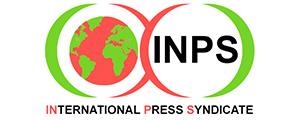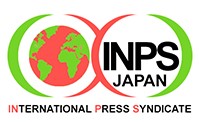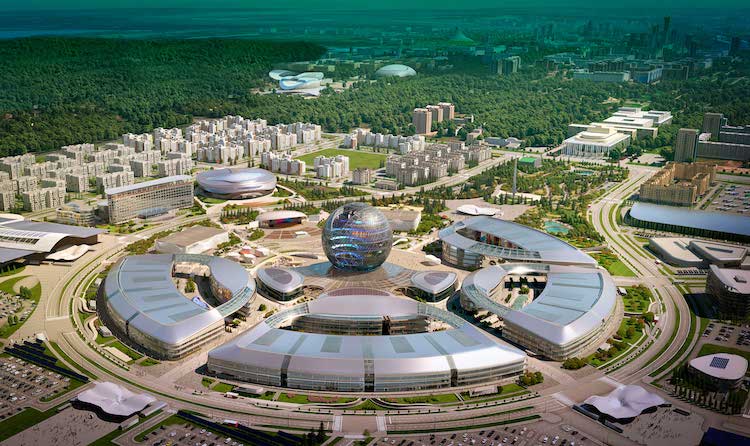By Ramesh Jaura
This is the fourth in a series of articles from Kazakhstan which being geographically located both in Asia and Europe, considers itself a Eurasian country. The articles are based on information gathered during a visit from June 7 to June 15 on the occasion of the opening of EXPO 2017 in Astana. Video clips accompany the articles in this series. – The Editor
ASTANA (IDN) – Twenty-five years of independence marked by 25 major achievements leading up to EXPO 2017 that focuses on ‘Future Energy’ have catapulted Kazakhstan on to the world map, firmly challenging the prevailing view that this, the world’s largest landlocked transcontinental country, is still part of the Eurasian steppes.
Touted by some as the ‘Disneyland for Adults’ and ‘a virtual reality beyond science fiction’ by others, EXPO 2017 shows the ways to access affordable, reliable, sustainable and modern energy for all. It is seventh of the 17 Sustainable Development Goals (SDGs) to transform our world by 2030, by way of ending “poverty in all its forms” as envisaged in Goal 1. – WATCH THE RELATED VIDEO –
The spirit behind the Exhibition is also to “make cities inclusive, safe, resilient and sustainable” as spelt out in Goal 11, ensuring “sustainable consumption and production patterns” (Goal 12), and helping “combat climate change and its impacts” (Goal 13).
In the run-up to EXPO 2017, Vicente Gonzalez Loscertales, the Secretary General of the International Exhibitions Bureau said, Astana EXPO would be “the best (among specialised exhibitions) for the last 25 years” – a statement that he could validate on the basis of long years of experience, among others as director of international participation in Seville 1992,
In January, the New York Times recommended places to visit in 2017 and ranked Kazakhstan and Astana EXPO 2017 among the top 30. EXPO officials expect five million visitors over the three-month duration.
A visitor to the Exhibition cannot escape the impression that the Kazakh government has organised an event of a global magnitude in Astana, which in 15-20 years has grown into an ultra-modern capital, studded with futuristic buildings, hotels, and skyscrapers designed, among others, by British and Japanese architects.
In 1999, UNESCO awarded Astana the medal and title of the City of Peace – a title it indubitably deserves: if only for the ‘Palace of Peace and Reconciliation’, a pyramid created by British architect Norman Foster, which hosts the triennial Congress of Leaders of World and Traditional Religions. The Congress is unique in itself.
Besides, the government seated in the City of Peace has launched initiatives at the United Nations for a nuclear-weapons-free world – a part of the reason that it was elected as a non-permanent member of the Security Council for the two- year period 2017-2019.
Also the three-month long EXPO 2017 until September 10, in which over 110 countries and more than 20 international organisations are participating, is serving as a hub connecting several cultural, political and economic activities.
The countries participating include the United States, China, Britain, France, Germany, Russia, Japan, South Korea. International organisations include besides the United Nations, the Shanghai Cooperation Organisation (SCO), the International Atomic Energy Agency (IAEA), and the Economic and Social Commission for Asia and the Pacific (ESCAP).
Kazakh President Nursultan Nazarbayev inaugurated EXPO 2017 on June 9 in the presence of seven heads of State and government and ten heads of international organisations, including President Xi Jinping of China, President Vladimir Putin of Russia, King Felipe VI of Spain as well as UN Secretary-General António Guterres.
The opening ceremony was preceded by the two-day SCO summit – which drew considerable public interest because of the admission of India and Pakistan as new members – and followed by the June 15-16 Astana Economic Forum on ‘New Energy – New Economy’ and the June 22-24 Eurasia Media Forum. A series of other conferences and fora will follow until September 10.
The overall theme of EXPO 2017, ‘Future Energy’, focuses on innovative and practical energy solutions in the future and their impact as spelt out by the subtitle: ‘Solutions for Tracking Humankind’s Greatest Challenge’. Accordingly, it is showcasing how social, economic and environmental challenges can be addressed.
The symbol of EXPO 2017 is the ‘Nur Alem’ pavilion of Kazakhstan. It is the world’s first ‘complete sphere’ building with a diameter of 80 and height of 100 meters. The Sphere includes the Future Energy Museum, which hosts a ‘Getting acquainted with Kazakhstan’ area and also demonstrates the main kinds of energy.
The national pavilion also comprises an exposition titled ‘Future Astana – the capital of Kazakhstan in 2050’ as part of the development roadmap, known as the Kazakhstan 2050 Strategy, the Space Energy Hall, and the Creative Energy Area comprising 28 Kazakhstan scientific projects and projects under the Green Economy concept.
It also includes a model of the Kazakh material reactor ‘Tokamak’ and a media wall with initiatives of President Nazarbayev in the field of energy and environmental protection.
The theme Future Energy is spread over seven floors within the spherical building. Whether it is a vision of Astana as a city of the future is presented on the eighth floor, space energy on the seventh, solar energy on the sixth, wind energy on the fifth, biomass on the fourth, harnessing the kinetic energy of the Planet Earth on the third or taming water to yield energy on the second floor, the hi-tec presentations are fascinating and real. [IDN-InDepthNews – 21 June 2017]
Related articles:
Astana Summit Favours UN Security Council Reform and a Polycentric World Order
What SCO Summit in Kazakhstan Means for India-Pak Ties
UN Chief Lauds Kazakhstan, Vows Close Cooperation with SCO
Photo: A bird’s eye view of EXPO 2017 Pavillons. Credit: expo2017astana.com


